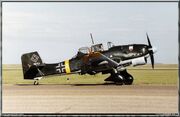The Ju 87 (Junkers 87) or StuKa (Sturzkampfflugzeug) was a light fighter-bomber aircraft of the Luftwaffe, known to dive bomb it's targets with incredible accuracy and power.
The aircraft was easily recognizable by its inverted gull wings, fixed spatted undercarriage and its infamous Jericho-Trompete ("Jericho Trumpet") wailing siren, becoming the propaganda symbol of German air power and the "Blitzkrieg" victories of 1939–1942. The StuKa's design included several innovative features, including automatic pull-up dive brakes under both wings to ensure that the aircraft recovered from its attack dive even if the pilot blacked out from the high acceleration. Although sturdy, accurate, and very effective, the Ju 87 was vulnerable to modern fighter aircraft, like many other dive bombers of the war. Its flaws became apparent during the Battle of Britain; poor manoeuvrability, lack of speed and defensive armament meant that the StuKa required heavy fighter escort to operate effectively.
StuKas are not the best fighter-bombers in the game, as they have to be directly over their target to hit them, making them easier to be hit by AA. Slow and poor in air combat as well, the StuKa is nothing to be boast about. They do, however, do fair amount of damage to ground targets, and are cheap and quick to produce.
History[]

The Ju 87's principal designer, Hermann Pohlmann, held the opinion that any dive-bomber design needed to be simple and robust. This led to many technical innovations, such as the retractable undercarriage being discarded in favour of one of the StuKa's distinctive features, its fixed and "spatted" undercarriage. Pohlmann continued to carry on developing and adding to his ideas and those of Dipl Ing Karl Plauth (Plauth was killed in a flying accident in November 1927), and produced the Ju A 48 which underwent testing on 29 September 1928.
The design of the Ju 87 had begun in 1933 as part of the Sturzbomber-Programm. The Ju 87 was to be powered by the British Rolls-Royce Kestrel engine. Ten engines were ordered by Junkers on 19 April 1934 for £ 20,514, 2 shillings and sixpence. The first Ju 87 prototype was built by AB Flygindustri in Sweden and secretly brought to Germany in late 1934. It was to have been completed in April 1935, but, due to the inadequate strength of the airframe, construction was not completed until October 1935. However, the mostly complete Ju 87 V1 W.Nr.c 4921 (less non-essential parts) took off for its maiden flight on September 17, 1935. The aircraft originally did not carry any registration, but later was given the registration D-UBYR. The flight report, by Hauptmann Willy Neuenhofen, stated the only problem was with the small radiator, which caused the power plant to overheat.
All StuKa units were moved to Germany's eastern border in preparation for the invasion of Poland. On the morning of August 15, 1939, during a mass formation dive bombing demonstration for high ranking commanders of the Luftwaffe at Neuhammer training grounds near Sagan, 13 Ju 87s and 26 crew members were lost when they crashed into the ground almost simultaneously. The planes dived through cloud, expecting to release their practice bombs and pull out of the dive once below the cloud ceiling, unaware that on that particular day the ceiling was too low and unexpected ground mist formed, leaving them no time to pull out of the dive.
Towards the end of the war, as the Allies gained air supremacy, the StuKa was being replaced by ground-attack versions of the Fw 190. By early 1944, the number of Ju 87 units and operational aircraft terminally declined. For the Soviet summer offensive, Operation Bagration, 12 Ju 87 Gruppen and five mixed Gruppen (including Fw 190s) were on the Luftwaffe's order of battle on June 26, 1944. Gefechtsverband Kuhlmey, a mixed aircraft unit, which included large numbers of StuKa dive bombers, was rushed to the Finnish front in the summer of 1944 and was instrumental in halting the Soviet fourth strategic offensive. The unit claimed 200 Soviet tanks and 150 Soviet aircraft destroyed for 41 losses. By this juncture, the Luftwaffe continued to resist Soviet air attacks but it had little impact on the ground war.
By January 31, 1945, only 104 Ju 87s remained operational with their units. The other mixed Schlacht units contained a further 70 Ju 87s and Fw 190s between them. Chronic fuel shortages kept the StuKas grounded and sorties decreased until the end of the war in May 1945.
Strategy and Tactics[]
- Despite being fairly effective fighter-bombers, the Stukas are more susceptible to anti-air fire because of the fact they must be directly over the target, and then dive down before pulling up. This is a slightly longer process, rendering the unit very exposed, unless it is in an area where the enemy has not deployed anti-air cannons. This is where the Stuka really shines.
- These are also best accompanied by Me 262's, as the jet fighters can rocket forward and secure air-superiority before the Ju 87's destroy enemy armor.
- The Stuka will split, dive down to the target, and drop the bomb once they are above the target. If you're under attack by enemy Stukas, exploit this against them. You can get your unit to move right and left with blitz ruse, as Stuka can miss the target.
Pros & Cons[]
This section is a stub, so be patient and expand it.
Weapons[]
| Weapon | ||||||||||
|---|---|---|---|---|---|---|---|---|---|---|
Heavy dive bomb |
1050 | 175 | 88 | 70 | 42 | 28 | 0m |
| Weapon | ||||||||||
|---|---|---|---|---|---|---|---|---|---|---|
Light dive bomb |
45 | 113 | 9 | 5 | 2 | 1 | 0 | 0m |
| Weapon | ||||||||||
|---|---|---|---|---|---|---|---|---|---|---|
Very light cal. AA gun |
20 | 400m |
Gallery[]
See also[]
| ||||||||||||||||||||||||||

